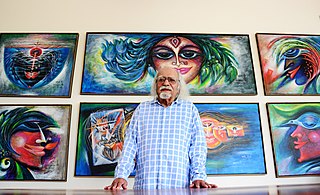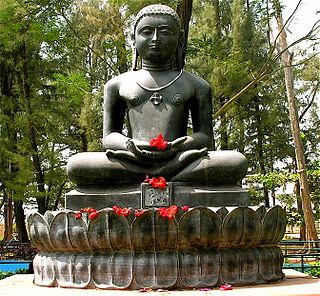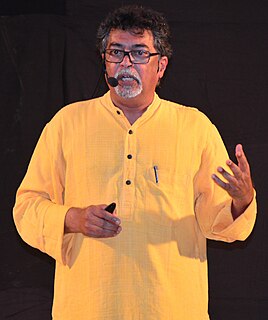
Goa Engineering College or Goa College of Engineering is a public college in Goa, India, offering courses in engineering disciplines and affiliated to Goa University. Founded in 1967 and situated at Farmagudi plateau, Ponda, it is the oldest engineering college in Goa, with over 2,200 students.
This article is about the culture of natives of the Indian state of Goa.

Mário João Carlos do Rosário de Brito Miranda, popularly known as Mario Miranda or Mario de Miranda, was an Indian cartoonist and painter based in Loutolim in the Indian state of Goa.

Bandora is a census town in Ponda Taluka in North Goa district in the state of Goa, India.

Francis Newton Souza was a British Asian artist. He was a founding member of the Progressive Artists' Group of Bombay. Souza's style exhibited both decadence and primitivism.

The state of Goa, in India, is famous for its beaches and places of worship. Tourism is its primary industry, and is generally focused on the coastal areas of Goa, with decreased tourist activity inland.
Patoleo are turmeric leaf stuffed leaf wrap, a dish which is mostly prepared on the western coast of India and other Indian Ocean islands. It is made of grated coconut, rice and jaggery, and cooked by wrapping and steaming in turmeric leaves.

Lambert Mascarenhas was an Indian journalist, independence activist, and writer from Goa. His family hailed from the Goan Catholic community.

Pilerne is a village situated in north Goa in the Bardez taluka of the North Goa district. It is rustic despite being fairly close to the North Goa tourist belt, and is considered a Census Town for the purposes of the Census. The village has mainly been inhabited by Goan Catholics.

The Museum of Christian Art, in the former colonial capital of Old Goa, is a museum of Christian art. It is currently closed for a renovation and refurbishment project.

Vamona Ananta Sinai Navelcar was an artist from Goa, India, who had studied and worked in Portugal, Mozambique, and Goa. Navelcar was born in Pomburpa village.

Goa is a state on the southwestern coast of India within the Konkan region, geographically separated from the Deccan highlands by the Western Ghats. It is surrounded by the Indian states of Maharashtra to the north and Karnataka to the east and south, with the Arabian Sea forming its western coast. It is India's smallest state by area and its fourth-smallest by population. Goa has the highest GDP per capita among all Indian states, two and a half times as high as the GDP per capita of the country as a whole. The Eleventh Finance Commission of India named Goa the best-placed state because of its infrastructure, and India’s National Commission on Population rated it as having the best quality of life in India. It is the third-highest ranking among Indian states in human development index.

Laxman Pai was an Indian artist and painter. He was a principal of the Goa College of Art, a post he held from 1977 to 1987. Pai was a recipient of several awards including India's third highest civilian honour of Padma Bhushan, awarded by the Government of India.

Jainism flourished in Goa during the rule of Kadamba dynasty. Broken sculptures of the Jain Tirthankara Suparshvanatha, belonging to the period of the Goan Kadamba ruler Shivachitta Permadi Dev, were discovered in an old Jain temple in Jainkot, Naroa.
Swati Shridhar Kerkar is an Indian social activist and politician. She is a member of Indian National Congress party.

The Goa Arts and Literature Festival (GALF) is an annual literary festival which takes place in the Indian coastal state of Goa, each December. It was founded in 2010.
Antonio Xavier Trindade (1870–1935) was an important painter of the Bombay School in the early 20th century.

Frederika Menezes is a Goan author, poet and artist. She is best known for her book, Unforgotten. A poem of hers, The Different Normals, features in the Class X English textbook of the Goa Board of Secondary & Higher Secondary Education (GBSHSE).

Subodh Kerkar is a Goan painter, sculptor and installation artist, and founder of the private art gallery Museum of Goa. He is known for his artworks and installations.
Angela Trindade (1909–1980) was an Indian painter famous for her Western-style portraits and Christian paintings in Indian style. A versatile artists, she also development of her own style, Trindadism, wherein the artist used the symbolic dimensions of the triangle and of trinity that conferred upon Angela a real individual approach to art.














